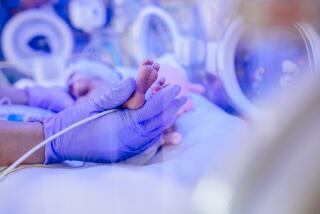High-Tech T-Shirt Could Help Track Babies at Risk
- Share via
WASHINGTON — Running to the park or the grocery store with 7-week-old Matthew Condon takes a lot of work: His parents also lug along a heavy monitor wired to Matthew’s tiny chest to sound the alarm if he stops breathing.
That high-pitched alarm can be lifesaving for babies like Matthew, who has a condition that causes apnea--brief stops in breathing. The monitors also are widely used for babies deemed at risk of sudden infant death syndrome.
But they’re not the easiest solution. They’re heavy, the sticky electrodes irritate babies’ tender skin and the wires frighten parents and can loosen to sound false alarms. A million false alarms, one doctor says in frustration.
So Georgia researchers are developing an easier heartbeat-and-breathing monitor for babies at risk of sudden death: a T-shirt with electronic sensors sewn into the fabric.
Matthew, who lives in Alpharetta, Ga., tried on a prototype, and the shirt hugged his chest snugly enough that the sensors were in the right spot to monitor his heart.
It’s a twist on a shirt developed by Georgia Tech engineers for the military to beam back to doctors the condition of soldiers wounded on the battlefield.
For Dr. Gary Freed, who is awaiting permission to begin testing the shirts on babies at Emory University this fall, converting the technology for civilian use is timely because more and more infants need at-home monitoring.
“A lot of that has to do with the managed care and insurance,” says Freed, whose Emory center cares for 900 babies on monitors. Premature or underweight babies, considered high risk, “normally would have been left in the hospital for a longer period, but instead they’re putting them out sooner with the monitors.”
All parents now are told to put babies to sleep on their back, not on their stomach--to reduce the risk of SIDS.
Putting high-risk babies on a cardiorespiratory monitor is a little controversial. Some critics say a baby predestined for SIDS cannot be revived even if the monitor blares a warning and that there’s not enough risk to justify monitoring preemies who appear healthy.
But many doctors say monitoring high-risk infants is important. At the least, it records heart rates that might help diagnose certain treatable illnesses, and can reassure parents who had another infant die.
For apnea, monitors can be lifesaving. Dr. Joe Hageman of Northwestern University’s Evanston Hospital recalls a baby suspected to have outgrown his apnea after no attacks for five weeks. Then his monitor detected three attacks in a row. Doctors revived him.
“It makes you crazy because you can’t predict” which baby is really at risk until a monitor blares, he said.
The shirt can be customized, says Georgia Tech engineer Sundaresan Jayaraman, who is seeking manufacturers. He’s getting interest from firefighters who want to detect hazardous gases and wonders if heart attack survivors could benefit from wearing a heart-monitor shirt.




